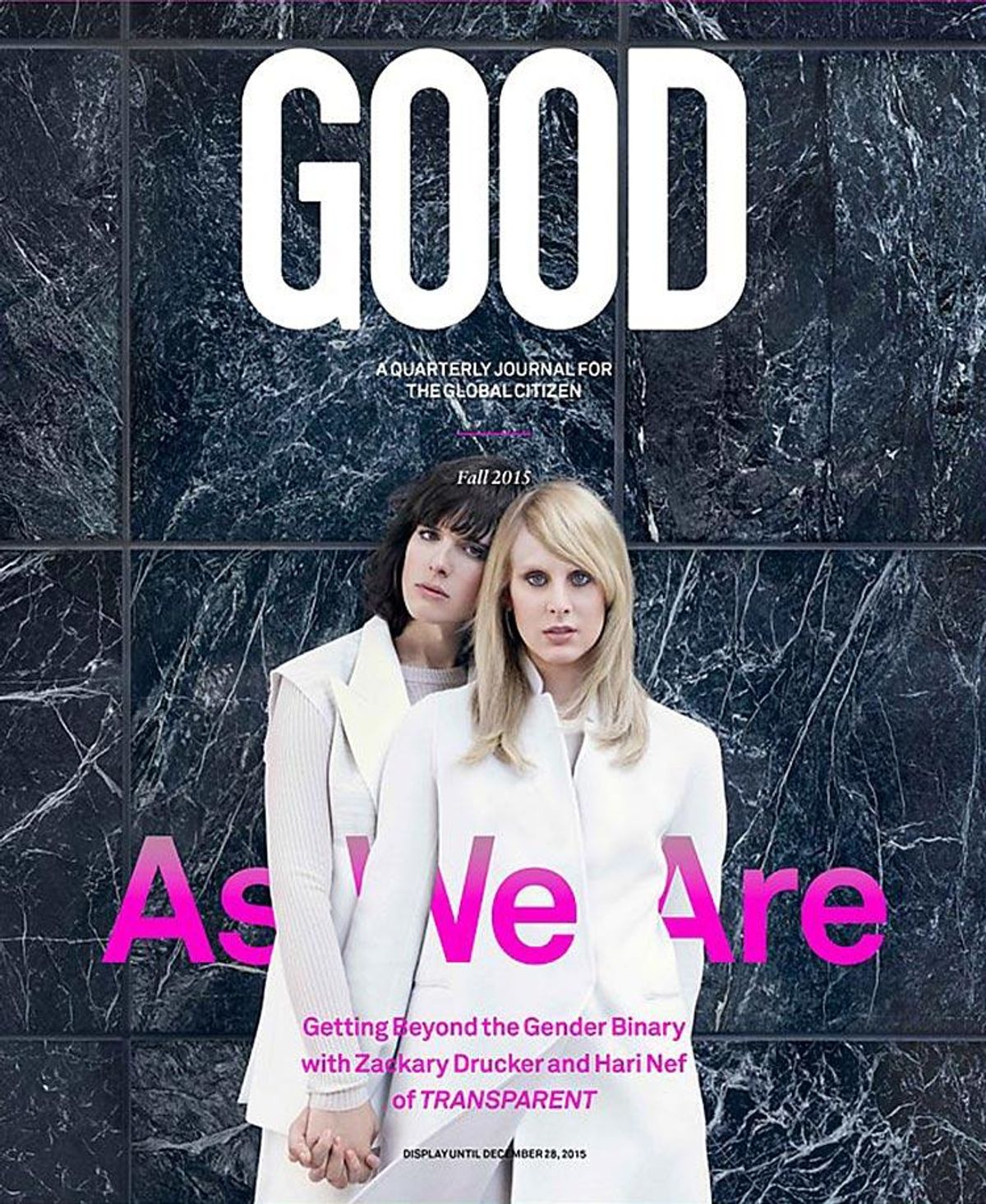"I've heard more than one trans person say that it's like the best of times and the worst of times," explains performance artist Zackary Drucker in a special joint interview with actress Hari Nef in the Fall 2015 issue of GOOD magazine, now on newsstands. "It's troubling the ways in which we're being offered these opportunities. Then there's this speculation that with the increased visibility of trans people, there's this unintended backlash hitting the most disenfranchised members of our community. We really do have a responsibility to bring the community up. I think the only way that's going to happen is through gainful employment."
Last year The Advocate praised Laverne Cox, the Orange Is the New Black actress, for her groundbreaking appearance on the cover of the June 9 issue of Time magazine. That issue trumpeted a new era of trans awareness dubbed "the transgender tipping point." This new era routinely features a roster of talented, articulate, camera-ready transgender spokespeople like Cox, and trans male bodybuilder Aydian Dowling, whose beauty adheres to traditional binary norms for female and male appearance.
In their conversation with GOOD, Drucker and Nef critique the so-called transgender tipping point, extolling its benefits, while also charging that it ignores the realities of the majority of trans people who do not enjoy the privileges of these celebrated few trans spokespeople.
"I honestly feel like it's purely a question of power," says Nef in the interview. She continues:
"Now we're in the limelight with this weird, narrow window to attain exposure and money and visibility, and every trans woman who can needs to try and get a piece. I want us all up here -- making money, pushing legislation, philanthropy, advocacy, calling people out -- but at the end of the day, because it's a media thing, it's probably going to be -- us here talking being a prime example -- trans women working in media and politics. As trans women with white privilege, we may be given more opportunities, and we have this dire responsibility to pass the mic. We need to advocate for trans women of color, and we need to do more than talk about it. The danger is so disproportionate right now to how much shine we're getting, and I'm more scared than I am triumphant."
Profiled this year in The Advocate's report on the real-life trans people influencing the Emmy-winning Amazon original series, Transparent, Drucker is a 32-year-old co-producer and advisor on the series, and a celebrated trans feminine photographer and performance artist who often works with the trans male artist Rhys Ernst.
Drucker grew up in the suburbs of Syracuse, New York, by what she describes to blog LA I'm Yours as "two really fantastic, progressive, educated parents." With a Master's in Fine Arts from the California Institute of the Arts and a Bachelor's in Fine Arts from New York City's School of Visual Arts, Drucker and Ernst's 2013 film She Gone Rouge was featured at Outfest, and the pair's photographic series, "Relationship" was shown at the prestigious Whitney Biennial. She is currently represented by the Luis De Jesus Gallery in Los Angeles.

Ten years Drucker's junior and a recent graduate of the undergraduate theater program at Columbia University, Nef is also a fashion model and writer who will be a featured actress in the upcoming second season of Transparent. Hailing from Newton, Mass., she walked the Eckhaus Latta and Hood by Air fashion shows this spring. This year Nef became the first trans model to be signed to the elite IMG Worldwide modeling agency, reports Vogue magazine.
In the lead image that opens the GOOD interview, Nef and Drucker hold hands against a background of cool, grey stone slabs. Both are resplendent in stark white pantsuits (Nef's by Stella McCartney and Drucker's by Narciso Rodriguez with a capelet by Todd Lynn). They boldly don white after Labor Day, their pants' overlong hems covering their feet in a carnivalesque manner.
Nef's hair is brown, bobbed, and tousled and her sleeves hang long, belling at the wrists. Drucker's shoulder-length hair is blond and pressed and her capelet covers her nearly-bare shoulders and arms. Both trans women stare gently yet commandingly at the camera. The image expresses a stunning, moody dissonance: tender sisterhood styled with a high fashion sheen.
Towards the end of the GOOD interview, Drucker talks about the intergenerational divide among trans leaders, highlighting the fact that it is only recently that prominent trans individuals have been recognized in the mainstream:
"I look around sometimes and think: Are we as a community actually being lifted up? Or are we just pawns in this sort of prurient curiosity of a cis-normative world? There's no answer, it's yet to be seen. Yes, I would like to be optimistic and say that we're moving toward the future where this next generation of trans people will finally be able to get ahead. Phyllis Frye, our nation's first openly transgender judge, is on the cover of The New York Times. Those people have always existed as well, people who have operated in an overground economy, and who have made an impact regardless of the obstacles of being trans, but that usually happens with late transitioners."
The beautiful dissonances and anxious criticisms within the words and images of Drucker and Nef in GOOD push the much-discussed transgender tipping point into an unprecedented complexity, where privilege and peril are styled and debated in equal measure.



















































































